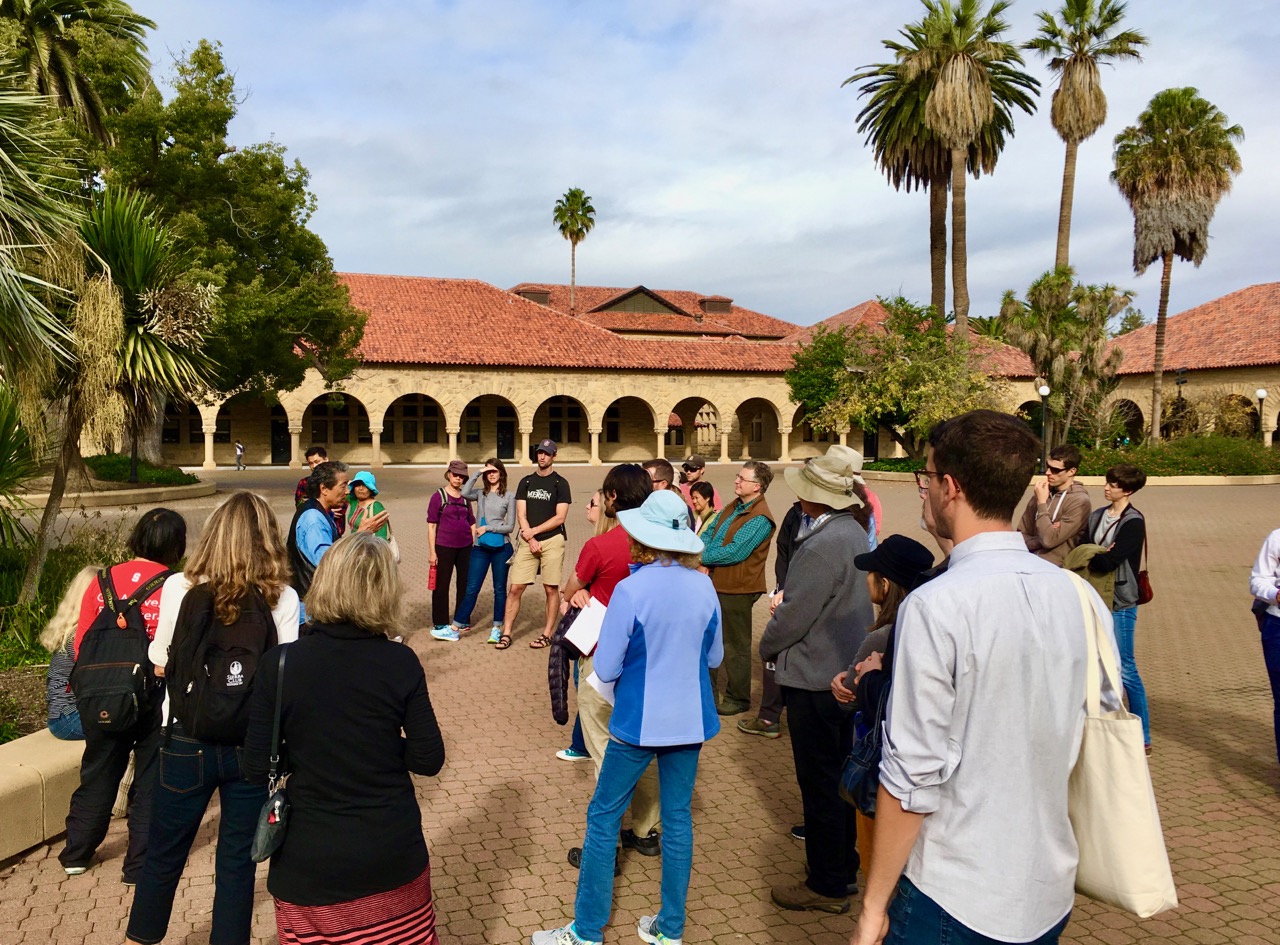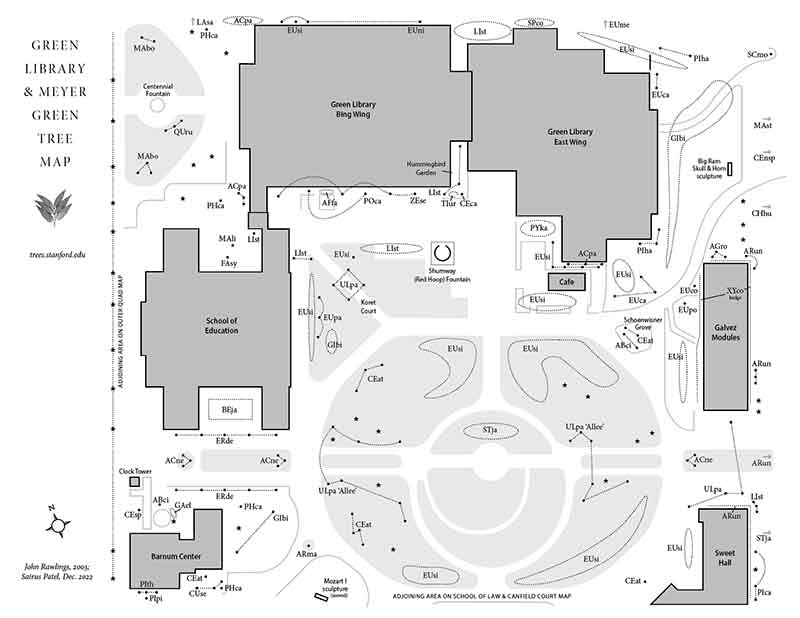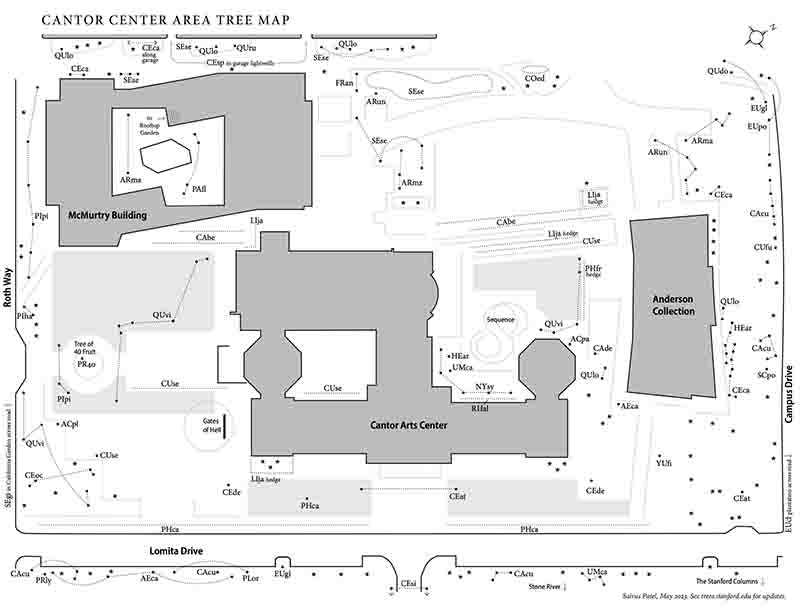Tree Maps & Tree Walks

Stanford
Tree tours for your class, dorm, or department can be a valuable and enjoyable group outing; contact us for possible arrangements. Contemplation by Design Week, usually in fall quarter, often offers guided tree walks.
Google map:
On phones, Google maps may work better if opened directly in your browser instead of in the Google Maps app.
| Map | Notes |
|---|---|
Stanford’s Noteworthy Trees Map (May 2024) Previous versions: |
NEW Latest map removed Quad’s removed windmill palm and Hoover Tower’s Atlas cedar (not planted in honor of President Harrison after all); added Olmsted’s olive crescent, Eucalyptus bridgesiana grove, and alligator juniper; and re-added Monterey cypress from 2005 map. More accessible specimens chosen for gray pine and valley oak. Some tree names and descriptions updated. Trio of champion trees clearly noted. 2018 version replaced the removed Eucalyptus viminalis with E. kruseana, chose another gray pine specimen (also due to a removal), and updated entry descriptions. |
PDF maps of specific areas on campus (note dates):
| Map | Notes |
|---|---|
|
Inner Quad Map (30 Apr 2024) 
Previous versions: |
NEW Latest map notes which trees still stand from the original Inner Quad planting in 1890, and which trees are featured in detailed scenes set in the Inner Quad in Richard Powers’ 2019 Pulitzer Prize winner The Overstory. Pair of Eucalyptus deglupta removed; a Brachychiton discolor added. A Butia odorata and Beaucarnea recurvata replace two original palms removed. Metrosideros changed from excelsa to kermadecensis (it may be a hybrid but more closely matches the latter). 2021 map corrects previous one (2016) as follows: Morus rubra is now M. alba. Livistona chinensis is now L. australis. Ligustrum lucidum is now Viburnum odoratissimum. |
|
Green Library & Meyer Green Map (Dec 2022) 
Previous versions: |
Latest map corrects previous one as follows: Eucalyptus laeliae is now E. camaldulensis; Cedrus libani is now C. atlantica. Other changes: Meyer Library replaced by Meyer Green Nov 2015. Salix babylonica was removed. Upcoming changes are well on their way, as the School of Education & Barnum Center area is being transformed. |
|
Cantor Center Area Map (May 2023) 
Previous versions: |
Latest map compared to previous one: Old Anatomy building removed. McMurtry Center and Anderson Collection built. Map area covered enlarged. Fortunately, the ancient and magnificent tree yucca remains. |
| Escondido Mall/South Quad Map (2003) | Carob in map was removed. Math Corner re-landscaped 2015: Eucalyptus citriodora (syn. Corymbia citriodora) removed, persimmon and camphor trees added. |
| School of Law/Canfield Court Map (2003) | Camperdown elm in map was removed. Fraxinus uhdei at School of Law replaced by Acer rubrum. |
| Wilbur Hall Map (2003) | Gleditsia triacanthos and two Brachychiton populneus in map were removed. |
| Old Union Map (2003) | All of the landscape shown on the map for the inner courts was replaced during the summer of 2007, except for one of the Quercus agrifolia. Phoenix canariensis were introduced to the inner courtyard. The beautiful Erythrina humeana facing White Plaza was also removed. ‘Natchez’ crape myrtle replaced the white mulberries on the southern face of the Clubhouse. |
From avocados to zelkovas: A sampler of Stanford trees. Campus Report, 14 Nov 1984, Karen Bartholomew.
Tiptoe through the Trees map. Produced by Stanford University Health Improvement Program in 1984, this is dated, but still a useful and innovative approach to campus tree appreciation.
Eucalyptus Dreams field trip (part of History 53S, Feb 2007).
Stanford Grounds Services: Arizona Garden & other points of interest (SU login may be needed).
Neighboring cities
Canopy offers monthly guided tree walks in neighborhoods in Palo Alto and surrounding communities. The maps are available online.
On Tree Walks
These maps enable one to visit and get acquainted with particular trees and learn their names. A major step on the path to familiarity is learning a name; thus armed, the explorer can look up information and talk to others about discoveries.
These Stanford maps, along with the Noteworthy Trees Map, can be used to create pleasant outings or guided tree walks. To be a tour guide, it is not necessary to be an expert. Experience shows that groups should be limited to about a dozen people; if there are more, you will find the laggards strolling up to a tree just as you are moving off with the main group to your next fascinating stop. Those bringing up the rear have, however, been enjoying their own conversation and don’t seem to mind missing your commentary, no matter how brilliant.
The seven Stanford detail maps (in PDF above) provide a good start for those planning tree tours. The areas mapped are centrally located, and have both a diversity and density of trees. Scale varies somewhat, but fixed features – buildings, pathways, streets, sculpture, and lawns – should allow fairly precise location.
Residents of neighboring cities are in the same climatic zone as Stanford and will find our tree collection relevant to their own interests. Conversely there are specimens of interest to campus dwellers that are located off campus. More than a dozen Palo Alto tree walks are available in printed form and online (see above) from Canopy, a local tree advocacy group.
About this Page: “On Tree Walks” is adapted from the book Trees of Stanford and Environs, by Ronald Bracewell, published 2005. The original seven (2003) PDFs of campus tree maps were by John Rawlings, with design by Tony Gee; updated maps have credits and date of update in the maps themselves.



